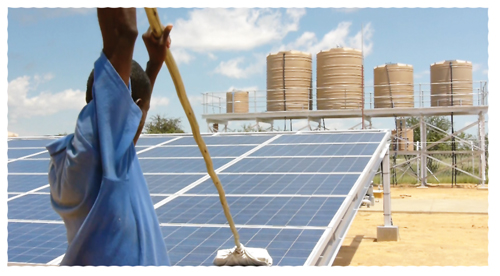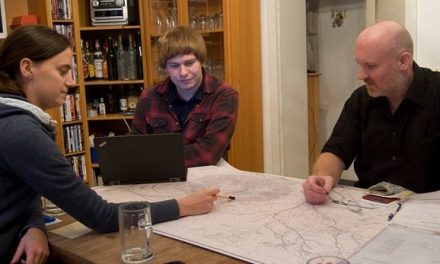
Solar energy drives rural desalination for healthy water

Regular cleaning of the solar panels ensure their efficiency to provide the energy required by the desalination plant.
Traditional water sources in the villages of Amarika and Akutsima are shallow hand-dug wells which are strongly saline and are microbiologically contaminated . “Therefore the idea of setting up a solar-driven desalination plant was essential to producefresh water with high purity suitable for drinking purposes.” said Marian Brenda of CuveWaters. She presented the findings of the project at the recent Namibia Water Investment Conference.
According to Brenda, these remote areas are known to have a high solar radiation so the use of other energy sources such as conventional fuel were not considered. This also reduces the environmental impacts of green house emmisions. Before the desalination plant, the villagers of Amarika and Akutsima used to collect water from the traditional hand dug wells, which were contaminated with algae, feaces and parasites and because the salinity of the water increased during dry seasons, the availability of water quantity was depended on the last rain season.
The desalination plants produce fresh water with a high chemical quality and low bacteriological contents.”Fresh water quality is constant throughout the year and the quantity of the water is independent from seasonal flunctuations,” Brenda highlighted.
Local caretakers and guards from the villages protect and clean the installations on a daily basis while a service provider, Aqua Services & Engineering (ASE) visits the plants every two months for maintenance, repairs and water analysis. Via data transmission satellite connection the manufacturer of the plants can monitor the plants from Germany, which helps to detect malfunctions early and to plan service trips. A Water Point Commitee is elected amongst the villagers, which is responsible for the distribution of the water.
CuveWaters is an international joint research project led by the Institute for Social-Ecological Research (ISOE) in cooperation with the Technical University Darmstadt in Germany and the Desert Research Foundation of Namibia (DRFN) as well as the Ministry of Agriculture, Water and Forestry (MAWF). The project is funded by the German Federal Ministry of Education and Research and is running from 2006 to 2013. A third phase is currently planned.
The CuveWaters’ pilot plants are spread across the Cuvelai-Etosha Basin. Four innovative technologies have been incorporated namely plants for rainwater harvesting, groundwater desalination and subsurface water storage. These pilot plants are located in different rural areas. Facilities for sanitation and water re-use are located in an urban site. By spreading the geographical allocation of these sites, the project partners take into account diverse local social-ecological situations.
The pilot plant for subsurface water storage is located in the village of Iipopo in the Oshana region. The facility consists of one underground tank and two ponds that store Oshana water. Up to ten households can use the stored water for small-scale gardening.
The sanitation and water re-use sub-project will start its operation in 2013 in the small town of Outapi (Omusati region). The concept includes sanitation facilities, a wastewater treatment plant and associated agricultural production.
CuveWaters bases its work on the 3R concept with its strategies for water re-use, recharge, and retention, unlocking considerable potential for improving the quality and availability of water.
The goal of the CuveWaters project is to further develop and implement an Integrated Water Resources Management (IWRM) system tailored to the Cuvelai-Etosha Basin in central-northern Namibia. The project will strengthen the potential of the region’s water resources. Future application depends on the development of innovative solutions by combining new and adapted technologies.













































